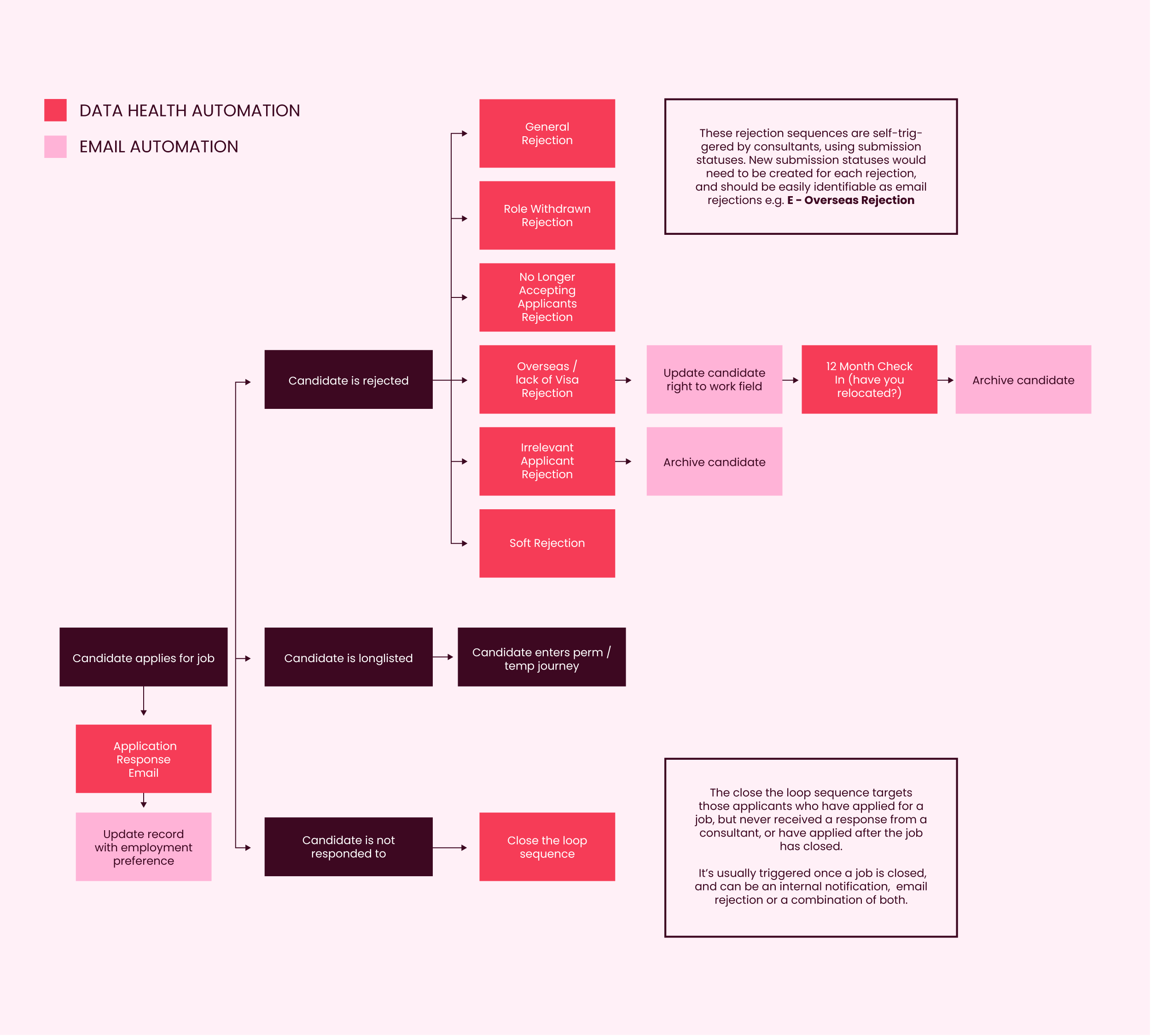We've all been there: A job gets swamped with applicants and while you'd love to speak with everyone, realistically, some will fall through the cracks.
This is actually a very solvable problem.
Today, I’m sharing three easy automations that’ll really enhance your applicant journey (and recruiter brand at the same time). Maybe you can’t talk to each applicant personally, but with modern recruitment tech you can ensure they at least hear back from you.
Not sure what automation even is? Start here instead: What is email automation, and should recruiters use it?
The 3 must-have applicant automations:
Application response emails
Rejection sequences
Close the loop sequences
1. Application response emails
An application response email is exactly what it sounds like: a candidate applies, the system responds to thank them – simple as that. This is one of the quickest automation wins in recruitment. Plus, it helps candidates feel assured that all the tech stuff worked and their application didn’t get lost in the spam filter.
Pro application response email tips
Use merge tags to bring in job data. Make sure to add job titles and job IDs to your email template using merge tags.
Merge tags are thrown into an email and fill with real text when you hit send (think “Hello %NAME%”). Adding the job title and ID means candidates have an easy way of identifying the role if they need to reach out for more info.
Add a pre-screen survey. If you ask applicants for key details up front, you can build out a better profile in your CRM/ATS without the admin. Think about what information will help consultants, e.g. their right to work, desired locations, job preferences, etc.
Tools like Bullhorn or Roi-AI will help here.
2. Rejection sequences
Automatic rejection emails get a bad rap, but the reality is recruiters don’t have the capacity to sit there rejecting hundreds of applicants. The trick to avoiding the usual issues here is to use the right rejection sequences.
What’s wrong with a generic rejection?
One of the main issues I see is that vague responses don’t really mean much. As a candidate, you know you’ve been rejected, but you don’t know why. The email isn't relevant. You wonder, did they even look at my application?
Instead, with specific reasons, maybe it’s still not good news, but at least it's clear.
Common rejection emails
General/Not Suitable
Overseas/no working rights
Role has been withdrawn
Role has been filled/too late for consideration
Candidate was irrelevant (that’s for bus drivers applying for a CFO position)
It’s worth noting that the generic "Sorry, your application was unsuccessful” email will still often come in handy, but if you’ve got these other templates up your sleeve, you’ll be well-prepared for a variety of situations.
Pro rejection email tips
Build a separate template for ‘soft’ rejections. Soft rejections are those candidates who aren’t right for this specific role, but you’d still like to chat to. Toss in a Calendly link or a CTA to get in touch and it keeps the conversation going.
Remember to be human. It might be a bot sending the email, but it doesn’t have to be a bot writing it. It’s always good to remind ourselves that empathy pays in recruitment.
Pick up the phone for advanced candidates. Automated rejections are generally for initial applicants. If we’ve had a proper human interaction with them, they’ll appreciate a more personal message. After all, they’ve given you and your client a lot of their time. Let’s give them some of ours.
3. Close the loop sequences
This is a very popular automation.
'Closing the loop’ is often a key metric for recruitment leaders. Yet, it’s super common to see huge volumes of applicants who, for various reasons, never hear anything (one CRM I saw recently had over 100k+ unresponded applicants from the previous 12 months!).
What is a close the loop automation sequence?
A close the loop automation sequence targets applicants who have applied for a job, but never received a response. It also targets those who put their name in the ring after the job was already closed – people coming into the ATS who often end up in no man’s land.
Here, the system recognises that the job has closed and lets you know if there’s folks waiting to hear from you. Alternatively, it can flick them an automatic message giving them the rejection on your behalf (or a mix of both). The choice is up to you.
Pro closing the loop tips
Check on your ads when closing a job. If you’ve still got ads running for a role but you close the job itself in your ATS, applicants will still be flowing in.
Personalise these rejections too. Using job statuses, you'll be able to personalise the rejection based on the reason the job was closed.
How to get started in automation as a recruiter
If you’re a recruiter just getting started in automation, these three are the lowest hanging fruit when it comes to the applicant journey. They’re simple to set up, they improve the communication experience for candidates and they’ll help to protect your recruiter reputation. A triple win.
Having trouble with the tech stuff? Don't beat your head against your laptop all day – we're here to help.
Check out more about how we help recruiters of all levels with their email marketing and automation, or flick me a message to start a conversation.
Applicant Journey Map Sample:





